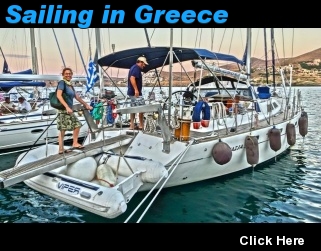Istanbul Guide
A Typical First Night in Istanbul
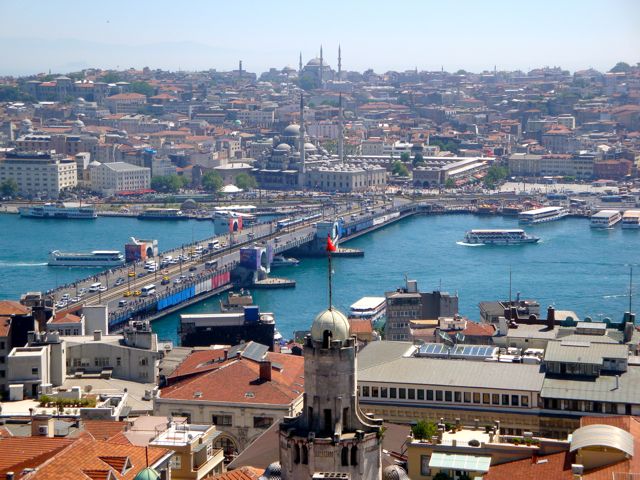 Yesterday morning I woke up for my last day in Istanbul.
(Constantinople if you are Greek). We were there for a week. We
had some time on our hands and a daughter who does not like long
car trips, otherwise we would have driven to Ipirus and walked the
Vikos Gorge. We had been in Istanbul in September and I was sick
the entire time so we had missed some pretty important sights. It
is not easy being Greek and having to admit that even though you
were in Constantinople you did not visit Agia Sophia, which to
most Greeks is more important than the Parthenon. Or to have
Turkish friends and have to admit you did not get as far as Taksim
Square or go to the Topkapi Palace. Istanbul was sort of an
embarrassment for me. I had been there and done little and now it
was time to rectify the situation. I knew that Andrea would take
Amarandi to the Grand Bazaar and that would make her happy, since
she loves to shop, and that the Turkish food would be similar
enough to Greek food so as not to freak her out like say French
Food, which on our trip to Paris she had avoided by staying in the
hotel and only going out at night for sushi. So on Friday morning
I suggested to Andrea that we go to Istanbul for a week and Andrea
thought that was a great idea. I went to Kayak and discovered that
a one-way ticket on Turkish-Air, leaving the next day cost about
$125. Then I checked the ferry schedules and came up with an
efficient plan that if everything fell into place, would be
relatively painless and we could leave Kea at noon and be eating
meze and drinking raki that evening. Even Amarandi was
semi-enthused, though she saw it as just a way for the time to
pass more quickly until her boyfriend Ernie arrived from the
states than sitting around the house in Kea, doing Facebook and
watching TV. Yesterday morning I woke up for my last day in Istanbul.
(Constantinople if you are Greek). We were there for a week. We
had some time on our hands and a daughter who does not like long
car trips, otherwise we would have driven to Ipirus and walked the
Vikos Gorge. We had been in Istanbul in September and I was sick
the entire time so we had missed some pretty important sights. It
is not easy being Greek and having to admit that even though you
were in Constantinople you did not visit Agia Sophia, which to
most Greeks is more important than the Parthenon. Or to have
Turkish friends and have to admit you did not get as far as Taksim
Square or go to the Topkapi Palace. Istanbul was sort of an
embarrassment for me. I had been there and done little and now it
was time to rectify the situation. I knew that Andrea would take
Amarandi to the Grand Bazaar and that would make her happy, since
she loves to shop, and that the Turkish food would be similar
enough to Greek food so as not to freak her out like say French
Food, which on our trip to Paris she had avoided by staying in the
hotel and only going out at night for sushi. So on Friday morning
I suggested to Andrea that we go to Istanbul for a week and Andrea
thought that was a great idea. I went to Kayak and discovered that
a one-way ticket on Turkish-Air, leaving the next day cost about
$125. Then I checked the ferry schedules and came up with an
efficient plan that if everything fell into place, would be
relatively painless and we could leave Kea at noon and be eating
meze and drinking raki that evening. Even Amarandi was
semi-enthused, though she saw it as just a way for the time to
pass more quickly until her boyfriend Ernie arrived from the
states than sitting around the house in Kea, doing Facebook and
watching TV. |
| So Saturday we woke up, got rid of any perishable food in the
fridge, drove to the port and put the Suzuki on the ferry. After a
one hour ferry trip we drove to the airport where Salvo from Swift
Car-Rentals took the car and we got on the flight to Istanbul
where we were met by a representative of the Neorion Hotel where
we were staying. For those who are visiting Istanbul let me take
this opportunity to pass on some valuable information. When you
arrive at Attaturk International Airport you need to get your visa
before you get on the long line for passport control. Otherwise
you will spend a half hour on line only to be told that you need
to go back and get a visa, and then once you have paid your 20
euros for the visa you have to convince the 500 people who are
ahead of you on line that you should be allowed to go to the
front. We actually just went to the line for VIPs and Flight Crew,
which was not even a line, just a security guard and he allowed us
to cut in front of the rest of the common people and people seemed
to accept it. But you can avoid the embarrassment by getting the
visa first. Actually the woman border guard who had told us we
needed a visa also told us just to come back to her and we would
not have to stand in line. But when we returned she was gone, a
clever plan to avoid conflict with exasperated tourists who would
rather scream and yell and be carted off to Turkish prison, rather
than have to get a visa and stand in line again after a long
flight. Of course this could all be avoided if there were signs
that told people that they needed the visa before going to
passport control instead of just having signs to each and letting
the tourist guess which goes first. |
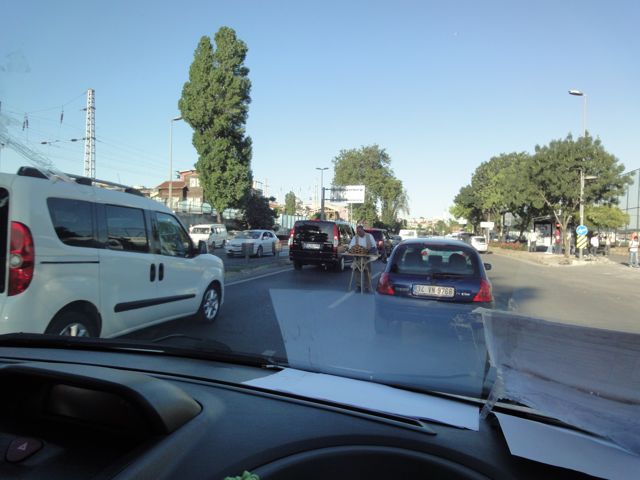 All things considered though it was still pretty easy and we still
got to the baggage carousel before our luggage did. There is
virtually no customs check so you just get your bag and go out the
door into the terminal and into a sea of guys all with signs with
names on them. There were hundreds. I slowly read each sign
because I knew that whoever was picking me up had no idea what I
looked like and every time I looked at a sign, the guy holding it
would think that I was the person they came to pick up and got really happy and then disappointed when I looked at the next sign. I felt like I was raising hope and dashing it just as quickly. Finally I
saw my name and the driver, a short fat guy who looked like he did
nothing but drive and walking was something he had done as a child
but rarely since. He was sincerely happy to see us though and easy
to follow through the crowd. He did not volunteer to help us with
our luggage but to be honest with you he did not seem physically capable of
it. Holding the sign with my name on it was enough of a challenge.
This guy was clearly a driver, nothing more, nothing less. Doing a
transfer for a hotel was not his thing unless it was picking
someone up at the hotel and leaving them at the airport. But he
had mastered two essential words of English. No Problem. When we
got to the hotel Mr Farouk, the owner confided in me that the
hotel had its own preferred drivers but in the summer there were
so many transfers they had to use other drivers, some not quite
ready for prime-time tourism. Our driver, despite his deficiencies
was better than some, who race through the narrow streets like
children on high-speed bumper cars, terrifying the passengers,
particularly those who are first time visitors and don't realize
that this is how people drive here where getting from point A to
point B means overcoming many obstacles including road work, other
cars and pedestrians. Since I drive in Athens I know that
close-calls are a part of every trip no matter how long or short.
I remember once I counted all the near mishaps driving from the
Hotel Attalos to the ferry in Pireaus and there were eleven. This
was the first time I had driven my car. It had about ten
kilometers on it and despite the fact that I was a novice at
maneuvering through Athens traffic, not one of the eleven would
have been my fault. It was all other drivers and pedestrians doing
stupid things (for example opening the door on a busy street
without looking to see if there was a car coming etc). And yet I
avoided every potential accident without even being a good driver.
So imagine someone who is a professional driver in Istanbul. They
live in a world of close calls and know that there is just enough
time to squeeze into the quickly disappearing space between the
large truck and the group of pedestrians crossing the street. It's
instinct. They can be talking on their cell phones while making a
move that would be considered risky by a NASCAR driver. Meanwhile
in the back seat the newly arriving tourist is ready for
intravenous Valium. It is no wonder that when you arrive at the
Hotel Neorion they offer you a complimentary glass of wine or a
raki. Honestly though, we have had four drivers on our trips to
Istanbul, three of them regular drivers for the hotel, and they
were all great. Better than I would be anyway. So if you feel
nervous about the driving style of your driver just watch the
scenery and don't look forward. You are in capable hands. Unless
of course the owner of the vehicle has lent it to his cousin from
the village so he can make some extra money. All things considered though it was still pretty easy and we still
got to the baggage carousel before our luggage did. There is
virtually no customs check so you just get your bag and go out the
door into the terminal and into a sea of guys all with signs with
names on them. There were hundreds. I slowly read each sign
because I knew that whoever was picking me up had no idea what I
looked like and every time I looked at a sign, the guy holding it
would think that I was the person they came to pick up and got really happy and then disappointed when I looked at the next sign. I felt like I was raising hope and dashing it just as quickly. Finally I
saw my name and the driver, a short fat guy who looked like he did
nothing but drive and walking was something he had done as a child
but rarely since. He was sincerely happy to see us though and easy
to follow through the crowd. He did not volunteer to help us with
our luggage but to be honest with you he did not seem physically capable of
it. Holding the sign with my name on it was enough of a challenge.
This guy was clearly a driver, nothing more, nothing less. Doing a
transfer for a hotel was not his thing unless it was picking
someone up at the hotel and leaving them at the airport. But he
had mastered two essential words of English. No Problem. When we
got to the hotel Mr Farouk, the owner confided in me that the
hotel had its own preferred drivers but in the summer there were
so many transfers they had to use other drivers, some not quite
ready for prime-time tourism. Our driver, despite his deficiencies
was better than some, who race through the narrow streets like
children on high-speed bumper cars, terrifying the passengers,
particularly those who are first time visitors and don't realize
that this is how people drive here where getting from point A to
point B means overcoming many obstacles including road work, other
cars and pedestrians. Since I drive in Athens I know that
close-calls are a part of every trip no matter how long or short.
I remember once I counted all the near mishaps driving from the
Hotel Attalos to the ferry in Pireaus and there were eleven. This
was the first time I had driven my car. It had about ten
kilometers on it and despite the fact that I was a novice at
maneuvering through Athens traffic, not one of the eleven would
have been my fault. It was all other drivers and pedestrians doing
stupid things (for example opening the door on a busy street
without looking to see if there was a car coming etc). And yet I
avoided every potential accident without even being a good driver.
So imagine someone who is a professional driver in Istanbul. They
live in a world of close calls and know that there is just enough
time to squeeze into the quickly disappearing space between the
large truck and the group of pedestrians crossing the street. It's
instinct. They can be talking on their cell phones while making a
move that would be considered risky by a NASCAR driver. Meanwhile
in the back seat the newly arriving tourist is ready for
intravenous Valium. It is no wonder that when you arrive at the
Hotel Neorion they offer you a complimentary glass of wine or a
raki. Honestly though, we have had four drivers on our trips to
Istanbul, three of them regular drivers for the hotel, and they
were all great. Better than I would be anyway. So if you feel
nervous about the driving style of your driver just watch the
scenery and don't look forward. You are in capable hands. Unless
of course the owner of the vehicle has lent it to his cousin from
the village so he can make some extra money. |
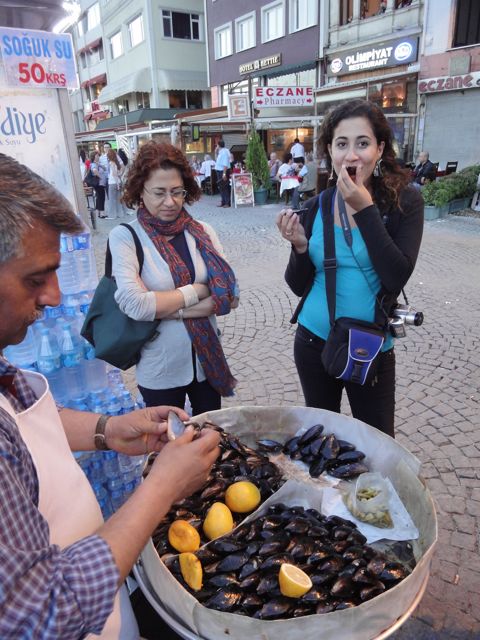 Just as when we arrived in Istanbul last September, our friend Cem
was waiting for us at the hotel. We dumped our bags in our room
and went up to the roof for the complimentary wine, and watched
the ships and ferries passing by on the Bosphorus and the Golden
Horn. We spent a lot of time doing that. It is really one of the
best places to have a quiet drink and the fact that the quiet
drink is also free makes it even better. They also have really
good Turkish wine. It's called Patera and they make a red and a
white. The Sirkeci Hotel group also owns several really good
restaurants and they all have Patera on the wine list and we did
not drink much else (besides raki of course). After the sun set we
walked down to Eminonu Pier so Amarandi could try her first midye,
the stuffed mussels sold on the quay. It's usually one guy with a
big tray with two or three sizes of mussels and you point to the
size you want and he opens them, squirts on some lemon and keeps
handing them to you until you tell him to stop. He has been
keeping score so when you are finished he tells you what you owe.
(They are cheap and filling). Some people say that you should not
buy mussels from the street, that you don't know where they come
from and that you should only buy them from a restaurant. Other
people, like Cem, say you never order them from a restaurant, you
should only order them from the street but you should know which
of the street venders have the best mussels. Cem had one guy in
mind at Eminonu but he had sold out so we walked across the Galata
Bridge, past the fish restaurants where in each one the touts try
to get you to come in to their restaurant, the only one that has
fresh fish, to Karakoy Pier where there was another guy Cem knew
had good mussels. Amarandi loved them of course and had around
seven big ones. I had four or five and I think Andrea had one. Cem
did not eat any, highly suspicious, but we let it pass because
they were so good and we did not want to stop eating them, even if
they were going to make us sick. Just as when we arrived in Istanbul last September, our friend Cem
was waiting for us at the hotel. We dumped our bags in our room
and went up to the roof for the complimentary wine, and watched
the ships and ferries passing by on the Bosphorus and the Golden
Horn. We spent a lot of time doing that. It is really one of the
best places to have a quiet drink and the fact that the quiet
drink is also free makes it even better. They also have really
good Turkish wine. It's called Patera and they make a red and a
white. The Sirkeci Hotel group also owns several really good
restaurants and they all have Patera on the wine list and we did
not drink much else (besides raki of course). After the sun set we
walked down to Eminonu Pier so Amarandi could try her first midye,
the stuffed mussels sold on the quay. It's usually one guy with a
big tray with two or three sizes of mussels and you point to the
size you want and he opens them, squirts on some lemon and keeps
handing them to you until you tell him to stop. He has been
keeping score so when you are finished he tells you what you owe.
(They are cheap and filling). Some people say that you should not
buy mussels from the street, that you don't know where they come
from and that you should only buy them from a restaurant. Other
people, like Cem, say you never order them from a restaurant, you
should only order them from the street but you should know which
of the street venders have the best mussels. Cem had one guy in
mind at Eminonu but he had sold out so we walked across the Galata
Bridge, past the fish restaurants where in each one the touts try
to get you to come in to their restaurant, the only one that has
fresh fish, to Karakoy Pier where there was another guy Cem knew
had good mussels. Amarandi loved them of course and had around
seven big ones. I had four or five and I think Andrea had one. Cem
did not eat any, highly suspicious, but we let it pass because
they were so good and we did not want to stop eating them, even if
they were going to make us sick. |
|
|
|
|
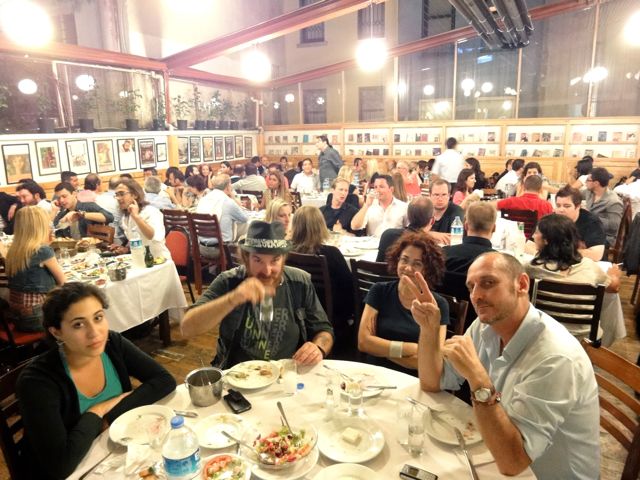 We met Cem's brother Demir at one called Yakup2 which was formerly
Greek. From the outside there are six or seven tables, but we walk
through the indoor seating area to a narrow stairway that leads to
a roof terrace that is massive, seating several hundred people.
Demir is waiting for us with a bottle of Tekirdag Rakisi, a raki
made from green grapes and we order a bunch of mezes and spend
several hours drinking eating and talking, just like in Greece. We
had the green olives wrapped in hamsi (anchovies), kuru fasulye
(small lime beans in olive oil), lakerda (marinated tuna), cacik
(like sadziki but without garlic), and the melon with cheese that
seems to come automatically in these fish places when you order
raki. We also had sheep's brains, not my idea. Not that I find
eating sheep brains any worse then eating kokoretsi or
testicles, because I know some Greek people (mostly
Greek-Americans) take great pleasure in eating sheep brains on
Easter Sunday. But it does not taste that good, at least
not good enough to get excited about, and the texture is
disgusting, more like oatmeal than meat, and it is so high in
cholesterol that if you decided you were going to try to live on
sheep brain you might not make it a week before you needed a heart
transplant. In other words unlike the stuffed mussels the pleasure
is not worth the risk. We met Cem's brother Demir at one called Yakup2 which was formerly
Greek. From the outside there are six or seven tables, but we walk
through the indoor seating area to a narrow stairway that leads to
a roof terrace that is massive, seating several hundred people.
Demir is waiting for us with a bottle of Tekirdag Rakisi, a raki
made from green grapes and we order a bunch of mezes and spend
several hours drinking eating and talking, just like in Greece. We
had the green olives wrapped in hamsi (anchovies), kuru fasulye
(small lime beans in olive oil), lakerda (marinated tuna), cacik
(like sadziki but without garlic), and the melon with cheese that
seems to come automatically in these fish places when you order
raki. We also had sheep's brains, not my idea. Not that I find
eating sheep brains any worse then eating kokoretsi or
testicles, because I know some Greek people (mostly
Greek-Americans) take great pleasure in eating sheep brains on
Easter Sunday. But it does not taste that good, at least
not good enough to get excited about, and the texture is
disgusting, more like oatmeal than meat, and it is so high in
cholesterol that if you decided you were going to try to live on
sheep brain you might not make it a week before you needed a heart
transplant. In other words unlike the stuffed mussels the pleasure
is not worth the risk. |
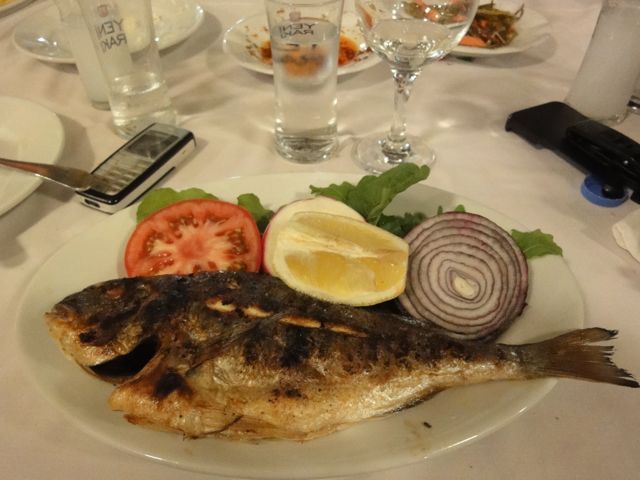 Eventually we got our main courses. Andrea ate lavrek which
is lavraki in Greek, usually farmed but tasty. In Turkey
they cook the fish simply, mostly grilled and maybe serve it with
a tomato and a piece of lettuce and lemon. We ate fish several
times and Andrea came to the incredible realization that none of
the Turks we ate with knew how to clean a fish. For those who have
not seen Andrea's tutorial video on how to clean and eat a fish
let me just describe the process because it is sort of an art
form. When the fish arrives, usually whole and looking pretty much
like a fish, you make an incision with your knife (it does not
have to even be sharp-even a butter knife will do) in the belly
and slice the fish parallel to the plate, then using your fork and
knife to unfold the fish so you have one side with the bone in and
the other without. Then you take out the spine which comes with
the head and tail, and separate the little fin bones from the two
filets. Now you can easily eat the now boneless fish after
seasoning it with lemon, salt and pepper (or for some of us Greeks
olive oil and garlic too). But several times we went to eat with
friends in fish restaurants and it was as if we were the only ones
who had ever eaten a fish. Some people just sort of dug away at it
with their fork like they were strip-mining for protein. Others
kind of scraped the meat off and prospected for bones in the pile
of meat, spitting them out or swallowing them and hoping for the
best. They loved fish and yet they had not mastered the basic
technique of de-boning one and making it safe for consumption. But
lets be fair. The Turks were not sea people, having originated
from the steppes of Asia. They have only been eating fish since
the fall of Constantinople in 1453. Major cultural changes like
knowing how to eat a fish do not happen overnight. Perhaps
expelling the Greeks was not such a good idea after all. Or at
least they should have waited until they had learned from them how
to clean a fish and then kicked them out. But I think that once we
get Andrea's video in to the hands of a few influential people we
can remedy the situation and accelerate the process of cultural
change and perhaps save the Turks another hundred years. It would
be ironic to say the least. Andrea's family left Constantinople
when the city fell to the Turks almost 600 years ago and came to
Kea with their gold and wealth and knowledge to build churches,
schools, fountains, and government while civilizing the island
which was just farmers and peasants. Now Andrea returns to Turkey
and shows them how to clean a fish, a lost art from the golden age
of Constantinople. Of course we don't really know if Turks don't
know how to eat a fish. All we know is that the people who we went
out to dinner with didn't and for all we know those people could
hate fish but they took us to fish restaurants because they know
Greeks love fish. Eventually we got our main courses. Andrea ate lavrek which
is lavraki in Greek, usually farmed but tasty. In Turkey
they cook the fish simply, mostly grilled and maybe serve it with
a tomato and a piece of lettuce and lemon. We ate fish several
times and Andrea came to the incredible realization that none of
the Turks we ate with knew how to clean a fish. For those who have
not seen Andrea's tutorial video on how to clean and eat a fish
let me just describe the process because it is sort of an art
form. When the fish arrives, usually whole and looking pretty much
like a fish, you make an incision with your knife (it does not
have to even be sharp-even a butter knife will do) in the belly
and slice the fish parallel to the plate, then using your fork and
knife to unfold the fish so you have one side with the bone in and
the other without. Then you take out the spine which comes with
the head and tail, and separate the little fin bones from the two
filets. Now you can easily eat the now boneless fish after
seasoning it with lemon, salt and pepper (or for some of us Greeks
olive oil and garlic too). But several times we went to eat with
friends in fish restaurants and it was as if we were the only ones
who had ever eaten a fish. Some people just sort of dug away at it
with their fork like they were strip-mining for protein. Others
kind of scraped the meat off and prospected for bones in the pile
of meat, spitting them out or swallowing them and hoping for the
best. They loved fish and yet they had not mastered the basic
technique of de-boning one and making it safe for consumption. But
lets be fair. The Turks were not sea people, having originated
from the steppes of Asia. They have only been eating fish since
the fall of Constantinople in 1453. Major cultural changes like
knowing how to eat a fish do not happen overnight. Perhaps
expelling the Greeks was not such a good idea after all. Or at
least they should have waited until they had learned from them how
to clean a fish and then kicked them out. But I think that once we
get Andrea's video in to the hands of a few influential people we
can remedy the situation and accelerate the process of cultural
change and perhaps save the Turks another hundred years. It would
be ironic to say the least. Andrea's family left Constantinople
when the city fell to the Turks almost 600 years ago and came to
Kea with their gold and wealth and knowledge to build churches,
schools, fountains, and government while civilizing the island
which was just farmers and peasants. Now Andrea returns to Turkey
and shows them how to clean a fish, a lost art from the golden age
of Constantinople. Of course we don't really know if Turks don't
know how to eat a fish. All we know is that the people who we went
out to dinner with didn't and for all we know those people could
hate fish but they took us to fish restaurants because they know
Greeks love fish. |
|
|
|
|
Help Support Matt's Guides
Do you enjoy using my site? Have you found it entertaining as well as useful? If so please show your appreciation by booking hotels through the travel agencies who contribute to my website when you book. If you are appreciative of all the free information you get on my websites you can also send
a donation through Paypal or Venmo or send a check to GreeceTravel.com/102 Old Pittsboro/Carrboro/NC 27510/USA
Join Matt Barrett's Greece Travel Guides Group on Facebook for comments, photos and other fun stuff. If you enjoy this website please share it with your friends on Facebook and other social media.

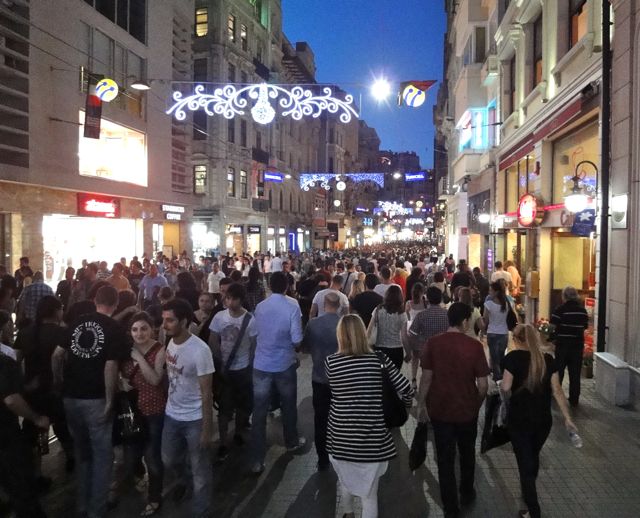 From Karakoy we took the world's second oldest metro to
Beyoglu. It's just one stop and the train goes back and forth up
and down the hill under the Galata Tower. At the top is Istiklal
Street which is to Istanbul as Ermou Street is to Athens except it
is jam packed with people at night and it is a lot longer. There
are all sorts of shops, department stores, consulates (including
the Greek), cafes, a couple Starbucks, street entertainers, and an
old trolley that goes slowly up and down Istiklal Street, parting
the crowd like Moses and the Red Sea. This is the European section
of Istanbul, called Beyoglu. Most of the buildings are impressive,
having once housed the embassies when Istanbul was the capital of
Turkey, before the fall of the Ottoman's. The side streets are
filled with shops and people too and in and around what is called
The Flower Passage, a sort of indoor street, are fish restaurants
called meyhanes, sort of a cross between a psaro-taverna and a mezedopoulion, and fish markets too.
From Karakoy we took the world's second oldest metro to
Beyoglu. It's just one stop and the train goes back and forth up
and down the hill under the Galata Tower. At the top is Istiklal
Street which is to Istanbul as Ermou Street is to Athens except it
is jam packed with people at night and it is a lot longer. There
are all sorts of shops, department stores, consulates (including
the Greek), cafes, a couple Starbucks, street entertainers, and an
old trolley that goes slowly up and down Istiklal Street, parting
the crowd like Moses and the Red Sea. This is the European section
of Istanbul, called Beyoglu. Most of the buildings are impressive,
having once housed the embassies when Istanbul was the capital of
Turkey, before the fall of the Ottoman's. The side streets are
filled with shops and people too and in and around what is called
The Flower Passage, a sort of indoor street, are fish restaurants
called meyhanes, sort of a cross between a psaro-taverna and a mezedopoulion, and fish markets too. 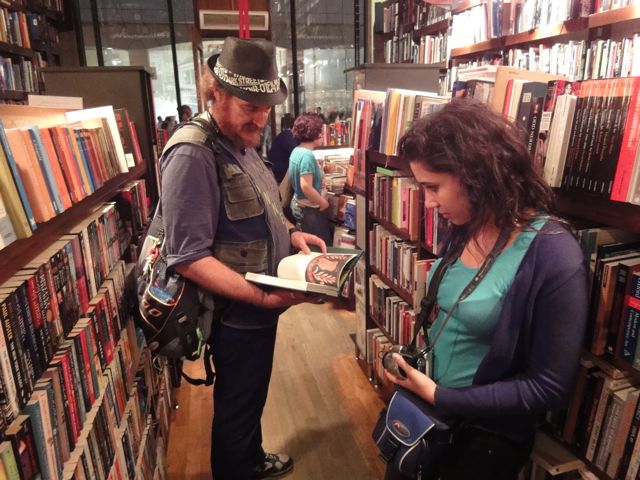 We made a quick stop at
Robinson Crusoe Bookshop which is to Istanbul as Shakespeare and
Company is to Paris, an English language bookshop and beacon to
foreign poets, writers and readers. We were just seeing what was
available as far as guidebooks since all we had was a 2003 Lonely
Planet Turkey, because we had left all our guidebooks in the USA,
not really expecting to be in Istanbul this summer. Lonely Planet
is OK but they don't pay their writers very much so they end up
being experts on what is cheap instead of what is good. John
Freely has lived in Istanbul for 43 years so he is one of those
guys like Edmund Keeley, Francis Leigh Fermer and Kevin Andrews in
Greece, the respected X-pats who know the culture well and share
it with everyone who comes later. But the body of work of the
Greek travel writers is miniscule compared to Freely who has
written some thirty books about Istanbul and Turkey. I imagine for
many people a John Freely sighting is like seeing Elvis or maybe
Stephen King. I pretty much decided to go with him as my Istanbul
guru after browsing through some of his books but somehow never
got around to buying one, relying instead on the out of date
Lonely Planet, Time Out Istanbul, and the cute girls in the lobby
of the Hotel Neorion who were happy to give me daily advice on
what to see and do.
We made a quick stop at
Robinson Crusoe Bookshop which is to Istanbul as Shakespeare and
Company is to Paris, an English language bookshop and beacon to
foreign poets, writers and readers. We were just seeing what was
available as far as guidebooks since all we had was a 2003 Lonely
Planet Turkey, because we had left all our guidebooks in the USA,
not really expecting to be in Istanbul this summer. Lonely Planet
is OK but they don't pay their writers very much so they end up
being experts on what is cheap instead of what is good. John
Freely has lived in Istanbul for 43 years so he is one of those
guys like Edmund Keeley, Francis Leigh Fermer and Kevin Andrews in
Greece, the respected X-pats who know the culture well and share
it with everyone who comes later. But the body of work of the
Greek travel writers is miniscule compared to Freely who has
written some thirty books about Istanbul and Turkey. I imagine for
many people a John Freely sighting is like seeing Elvis or maybe
Stephen King. I pretty much decided to go with him as my Istanbul
guru after browsing through some of his books but somehow never
got around to buying one, relying instead on the out of date
Lonely Planet, Time Out Istanbul, and the cute girls in the lobby
of the Hotel Neorion who were happy to give me daily advice on
what to see and do. 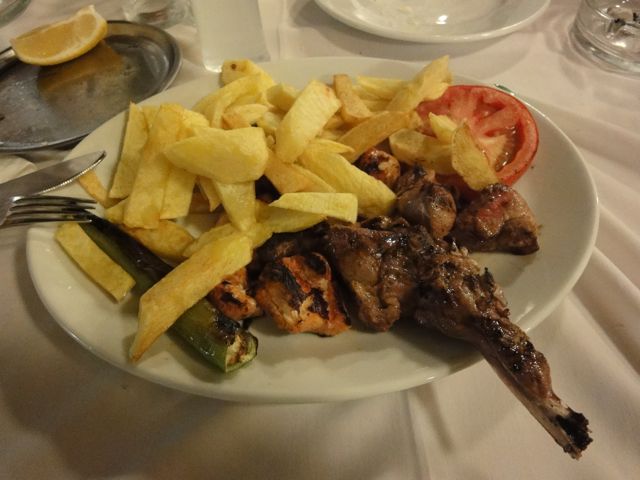 I ordered the mixed grill which is like a mixed grill at my
favorite restaurant in Athens only half the price, a quarter of
the meat, no sausage, and twice the potatoes. I figured it was a
good way to get an idea of what meats were done well. For me the
spicier the meat the better so I liked the doner kebabs which are
minced meat and spices packed together on a skewer and grilled.
Everything else tasted as you would expect. Grilled chicken tasted
surprisingly similar to grilled chicken and grilled lamb to
grilled lamb and grilled beef to.... well you get the idea. There
is no pork though in Turkish cooking. Like the Jews, Muslims don't
eat pig so all the yummy looking sausages in the butcher shops are
made of beef and the bacon served at the hotel breakfast buffet is
veal. In a way it is sad that two cultures that will never know
the joy of eating baby-back ribs, or NC style pulled pork BBQ, or
roasted suckling pig from Yiannis, don't get along. But it is just
as tragic that the people of India who practice Hinduism will
never know the taste of Turkish pastourma, the most pleasurable use of a cow known to mankind.
I ordered the mixed grill which is like a mixed grill at my
favorite restaurant in Athens only half the price, a quarter of
the meat, no sausage, and twice the potatoes. I figured it was a
good way to get an idea of what meats were done well. For me the
spicier the meat the better so I liked the doner kebabs which are
minced meat and spices packed together on a skewer and grilled.
Everything else tasted as you would expect. Grilled chicken tasted
surprisingly similar to grilled chicken and grilled lamb to
grilled lamb and grilled beef to.... well you get the idea. There
is no pork though in Turkish cooking. Like the Jews, Muslims don't
eat pig so all the yummy looking sausages in the butcher shops are
made of beef and the bacon served at the hotel breakfast buffet is
veal. In a way it is sad that two cultures that will never know
the joy of eating baby-back ribs, or NC style pulled pork BBQ, or
roasted suckling pig from Yiannis, don't get along. But it is just
as tragic that the people of India who practice Hinduism will
never know the taste of Turkish pastourma, the most pleasurable use of a cow known to mankind. 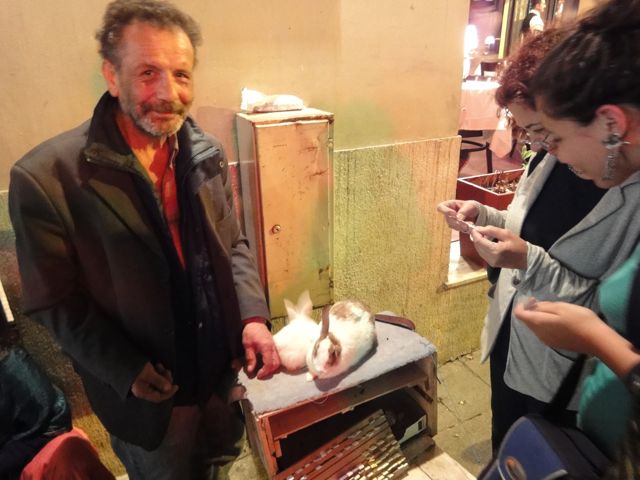 Almost as tragic for us
though, was that the various foods that were now inhabiting the
stomach of Amarandi, the stuffed mussels, sheep brains, fish,
beans and meats, decided that like the Jews, Muslims, Hindu and
Christians of the world, they could not get along either, causing
an internal upheaval and great suffering for my daughter who
wanted to go home immediately, though not before getting her
fortune told by a rabbit outside the restaurant. Proving that
Istanbul is indeed a magical place, the rabbit chose from the
folded pieces of paper, the one which read: #35. you love so
much someone and you are going to crazy when you don't see him.
you are suddenly wake up at midnight and you waste your sleeps.
but don't worry he-she loves you to. you will be happy soon.
Not grammatically correct but far beyond what you would get from a
Chinese fortune cookie and essentially right on the nose
considering that the only reason Amarandi agreed to come to Turkey was
because she thought it would make the time pass quicker til her
boyfriend came to Greece. So, how is it that a Turkish rabbit got it so
right with my daughter? When I went to a human psychic in
1986 she told me that Lisa Tuchek was my soulmate. And yet I have
not seen her in 25 years except on Facebook. Did the psychic just
get it wrong? Are Turkish rabbits better fortunetellers than human
American psychics? Do Turks eat rabbits? Do cows and pigs know the
future too? What about cats and dogs? Are we humans the only
beings on the planet who do not know who we are and what the
future has in store for us? These questions went through my mind
in the taxi home and through the night until after 4:44am when the
muezzin called the faithful to prayer from the mosque at Hoca Pasa
street and I finally fell asleep, only to dream of Mavromatis'
goats and sheep trying to convince him not to take them to the
slaughterhouse below the church of Agios Constantinos, named for
Constantine, the Emperor of Constantinople, now Istanbul. A
fitting close to a pretty weird day that began on the island of
Kea and ended in Turkey.
Almost as tragic for us
though, was that the various foods that were now inhabiting the
stomach of Amarandi, the stuffed mussels, sheep brains, fish,
beans and meats, decided that like the Jews, Muslims, Hindu and
Christians of the world, they could not get along either, causing
an internal upheaval and great suffering for my daughter who
wanted to go home immediately, though not before getting her
fortune told by a rabbit outside the restaurant. Proving that
Istanbul is indeed a magical place, the rabbit chose from the
folded pieces of paper, the one which read: #35. you love so
much someone and you are going to crazy when you don't see him.
you are suddenly wake up at midnight and you waste your sleeps.
but don't worry he-she loves you to. you will be happy soon.
Not grammatically correct but far beyond what you would get from a
Chinese fortune cookie and essentially right on the nose
considering that the only reason Amarandi agreed to come to Turkey was
because she thought it would make the time pass quicker til her
boyfriend came to Greece. So, how is it that a Turkish rabbit got it so
right with my daughter? When I went to a human psychic in
1986 she told me that Lisa Tuchek was my soulmate. And yet I have
not seen her in 25 years except on Facebook. Did the psychic just
get it wrong? Are Turkish rabbits better fortunetellers than human
American psychics? Do Turks eat rabbits? Do cows and pigs know the
future too? What about cats and dogs? Are we humans the only
beings on the planet who do not know who we are and what the
future has in store for us? These questions went through my mind
in the taxi home and through the night until after 4:44am when the
muezzin called the faithful to prayer from the mosque at Hoca Pasa
street and I finally fell asleep, only to dream of Mavromatis'
goats and sheep trying to convince him not to take them to the
slaughterhouse below the church of Agios Constantinos, named for
Constantine, the Emperor of Constantinople, now Istanbul. A
fitting close to a pretty weird day that began on the island of
Kea and ended in Turkey.
